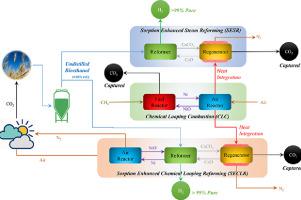Chemical Engineering and Processing: Process Intensification ( IF 3.8 ) Pub Date : 2021-11-23 , DOI: 10.1016/j.cep.2021.108733 Shadab Alam 1, 2 , N. Lingaiah 1 , Y. Soujanya 1 , C. Sumana 1

|
This work presents the design and optimization of two intensified and eco-friendly schemes for high purity H2 production from non-fuel grade/undistiled bioethanol through detailed thermodynamic investigation using Aspen plus models. Both of them are chemical looping combustion (CLC) integrated processes; namely, sorption enhanced steam reforming (CLC-SESR) and sorption enhanced chemical looping reforming (CLC-SECLR). Further, the heat and power demand of these processes are met by integrating with heat recovery and steam generation, and power generation sections, thus making them energy-wise self-sustainable. Steady-state Aspen Plus models have been developed for both the schemes, and the processes are investigated thermodynamically to determine the optimal operating parameters through sequential parametric sensitivity analysis. The results demonstrated the efficacy of the proposed CLC-SESR and CLC-SECLR schemes in facilitating low temperature reforming of partially distilled bioethanol of 14 mole % (34.5% by vol.) concentration at 550 °C and 500 °C, respectively resulting in optimal H2 yield of 97.38% and 82.45%, H2 purity of 99.15% and 99.71 %, energy efficiency of 39.47% and 37.30% along with CO2 capture efficiency of 99.13% and 99.58%, respectively. Further, reforming of undistilled bioethanol 5 mol% (14.6% by vol.) obtained directly from fermentation step, resulted in improved , and of 99.92%, 99.63%, and 99.48% respectively for CLC-SESR and 83.31%, 99.91% and 99.71% respectively for CLC-SECLR, at the expense of slight decrease in by ≈ 3% in both schemes. These results on comparison with the results of conventional steam reforming and chemical looping reforming with carbon capture demonstrate the outperformance of proposed schemes in terms of achieving more than 99% , and at almost the same efficiency as of the conventional reforming schemes.
中文翻译:

使用原位 CO2 捕获的强化化学循环重整过程,用于从非燃料级生物乙醇生产高纯度 H2
这项工作提出了两种高纯度 H 2强化和环保方案的设计和优化使用 Aspen plus 模型通过详细的热力学研究从非燃料级/未蒸馏的生物乙醇生产。两者都是化学循环燃烧(CLC)集成工艺;即吸附增强蒸汽重整 (CLC-SESR) 和吸附增强化学循环重整 (CLC-SECLR)。此外,这些过程的热量和电力需求通过与热回收和蒸汽产生以及发电部分相结合来满足,从而使它们在能源方面能够自我维持。已经为这两种方案开发了稳态 Aspen Plus 模型,并通过连续参数灵敏度分析对过程进行了热力学研究,以确定最佳操作参数。2产量97.38% 和 82.45%,H 2纯度 99.15% 和 99.71% 的能源效率 39.47% 和 37.30% 以及 CO 2捕获效率分别为 99.13% 和 99.58%。此外,直接从发酵步骤中获得的未蒸馏生物乙醇 5 mol%(14.6% 体积)的重整导致, 和 CLC-SESR 分别为 99.92%、99.63% 和 99.48%,CLC-SECLR 分别为 83.31%、99.91% 和 99.71%,代价是 在两种方案中都增加了 ≈ 3%。这些结果与传统蒸汽重整和带有碳捕获的化学循环重整的结果相比,证明了所提出的方案在实现超过 99% 的性能方面表现出色, 和 与传统重整方案的效率几乎相同。











































 京公网安备 11010802027423号
京公网安备 11010802027423号